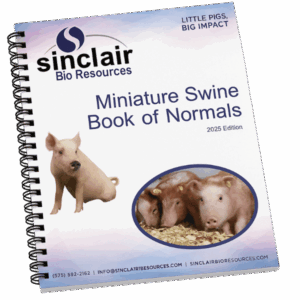The basic cause of coronary artery disease is a buildup of abnormal lipid and fibrous plaques that narrow the coronary arteries and deprive the heart of the blood and the oxygen it needs; this disease accounts for almost 500,000 deaths every year in the United States alone.
In conjunction with risk management, there are a number of therapeutic and life-saving pharmaceuticals available for treatment of heart disease and better drugs with fewer undesirable side effects are constantly being developed. Traditionally, the preclinical process of drug development includes animal model studies; miniature swine are frequently the best species to model human cardiovascular disease.
Pigs have been used for over 50 years as models for research into cholesterol and lipoprotein metabolism with application to atherogenesis. The pig is an excellent model for human cardiovascular research because of a number of similarities to the human; the anatomy of the coronary arteries and the pattern of development of collateral circulation after permanent ischemic episodes are two important similarities. The predominant bloodborne cholesterol transporter is low-density lipoprotein (LDL) as it is in humans as well. Additionally, miniature swine are omnivores like humans, making them favorable models for nutritional studies related to cholesterol and lipoprotein metabolism.
Sinclair Bio Resources is experienced in producing atherosclerotic miniature swine. Pigs naturally develop atherosclerosis; aortic streaks are observed in young pigs within a few weeks when fed diets high in fat, particularly saturated fat, and cholesterol. Lesions that produce partial occlusion of arteries do not appear until experimental diets are fed for months, but the disease state may be hastened by mechanically denuding the arterial intima. The miniature swine atherosclerosis model can be accelerated by intimal injury via balloon rasping, or by over-stretching the arterial wall, feeding high fat, high cholesterol (HFHC) diets, creating blood flow restriction, or inducing diabetes.

